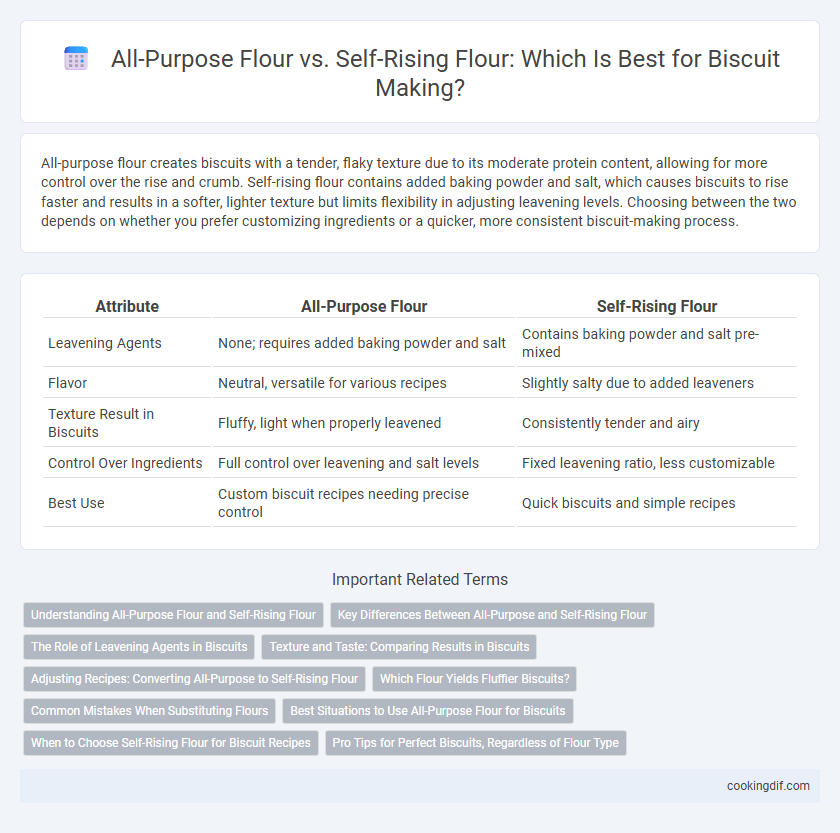All-purpose flour creates biscuits with a tender, flaky texture due to its moderate protein content, allowing for more control over the rise and crumb. Self-rising flour contains added baking powder and salt, which causes biscuits to rise faster and results in a softer, lighter texture but limits flexibility in adjusting leavening levels. Choosing between the two depends on whether you prefer customizing ingredients or a quicker, more consistent biscuit-making process.
Table of Comparison
| Attribute | All-Purpose Flour | Self-Rising Flour |
|---|---|---|
| Leavening Agents | None; requires added baking powder and salt | Contains baking powder and salt pre-mixed |
| Flavor | Neutral, versatile for various recipes | Slightly salty due to added leaveners |
| Texture Result in Biscuits | Fluffy, light when properly leavened | Consistently tender and airy |
| Control Over Ingredients | Full control over leavening and salt levels | Fixed leavening ratio, less customizable |
| Best Use | Custom biscuit recipes needing precise control | Quick biscuits and simple recipes |
Understanding All-Purpose Flour and Self-Rising Flour
All-purpose flour provides a neutral base with moderate protein content ideal for versatile biscuit recipes, allowing precise control over leavening agents added separately. Self-rising flour contains pre-mixed baking powder and salt, streamlining the process by integrating leavening directly, which produces lighter, fluffier biscuits with increased rise. Knowing the distinct compositions--especially the leavening factors--informs the choice between these flours to match desired biscuit texture and flavor outcomes.
Key Differences Between All-Purpose and Self-Rising Flour
All-purpose flour contains a moderate protein level, ideal for a tender yet sturdy biscuit texture, while self-rising flour includes baking powder and salt, providing a leavening agent that helps biscuits rise without added ingredients. The key difference lies in self-rising flour's built-in chemical leaveners, making it convenient but less versatile than all-purpose flour, which requires separate leavening agents for proper biscuit fluffiness. Choosing between them affects biscuit crumb, rise, and flavor, with all-purpose flour offering control over the leavening process and self-rising flour simplifying preparation.
The Role of Leavening Agents in Biscuits
Self-rising flour contains leavening agents such as baking powder and salt, which provide consistent rise and tender texture in biscuits without additional ingredients. All-purpose flour lacks these leavening agents, requiring separate addition of baking powder or baking soda to achieve proper biscuit lift and flakiness. The controlled amount of leavening in self-rising flour simplifies the biscuit-making process and ensures reliable results.
Texture and Taste: Comparing Results in Biscuits
All-purpose flour produces biscuits with a denser texture and a more neutral taste, allowing for greater control over flavor additions, while self-rising flour yields lighter, fluffier biscuits due to the inclusion of baking powder and salt. The leavening agents in self-rising flour create a tender crumb and slightly tangy taste that enhances overall biscuit flavor. Texture differences are evident as all-purpose flour requires added leavening to achieve similar rise and softness, impacting both the mouthfeel and taste profile of the final biscuit.
Adjusting Recipes: Converting All-Purpose to Self-Rising Flour
To convert all-purpose flour to self-rising flour for biscuit making, add 1 1/2 teaspoons of baking powder and 1/4 teaspoon of salt per cup of all-purpose flour. This adjustment ensures proper leavening and flavor balance, mimicking the chemical properties of self-rising flour. Precise measurement of these leavening agents is crucial for achieving tender, fluffy biscuits with the desired rise.
Which Flour Yields Fluffier Biscuits?
Self-rising flour contains baking powder and salt, which react during baking to create lighter, fluffier biscuits without additional leavening agents. All-purpose flour requires added baking powder and salt to achieve similar results but offers more control over biscuit texture and rise. For naturally fluffier biscuits, self-rising flour tends to yield a softer, more airy crumb due to its pre-mixed leavening components.
Common Mistakes When Substituting Flours
Using all-purpose flour instead of self-rising flour in biscuit recipes often leads to texture and rising issues due to the absence of leavening agents like baking powder and salt. A common mistake is failing to add the correct amount of baking powder and salt when substituting all-purpose flour, resulting in dense, flat biscuits. Accurate measurements and understanding the leavening differences between these flours are essential to achieve the desired light and fluffy biscuit texture.
Best Situations to Use All-Purpose Flour for Biscuits
All-purpose flour is ideal for biscuits when a versatile texture and moderate rise are desired, providing a balanced crumb that is tender yet sturdy enough to hold fillings. It works best in recipes where control over leavening agents is important, allowing bakers to add their own baking powder and salt for customized flavor and rise. This flour is preferred in homemade or scratch biscuits requiring adaptability for both flaky and fluffy results.
When to Choose Self-Rising Flour for Biscuit Recipes
Self-rising flour is ideal for biscuit recipes when a light, fluffy texture with consistent rise is desired, as it contains pre-mixed baking powder and salt. Choose self-rising flour to simplify preparation and ensure even leavening without measuring additional ingredients. For recipes requiring precise control over leavening or salt levels, all-purpose flour offers greater flexibility.
Pro Tips for Perfect Biscuits, Regardless of Flour Type
For perfect biscuits, understanding flour types is crucial: all-purpose flour offers control over leavening agents, while self-rising flour includes baking powder and salt for convenience. When using all-purpose flour, accurately measure and add baking powder and salt to match self-rising flour levels to ensure proper rise. Maintain cold ingredients and minimal handling of the dough to achieve light, flaky biscuits regardless of flour choice.
All-purpose flour vs self-rising flour for biscuit making Infographic

 cookingdif.com
cookingdif.com